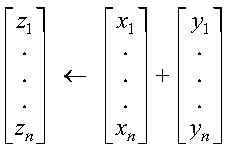

These subprograms perform the following computation, using vectors x, y, and z:
| x, y, z | Subprogram |
| Short-precision real | SVEA |
| Long-precision real | DVEA |
| Short-precision complex | CVEA |
| Long-precision complex | ZVEA |
| Fortran | CALL SVEA | DVEA | CVEA | ZVEA (n, x, incx, y, incy, z, incz) |
| C and C++ | svea | dvea | cvea | zvea (n, x, incx, y, incy, z, incz); |
| PL/I | CALL SVEA | DVEA | CVEA | ZVEA (n, x, incx, y, incy, z, incz); |
The computation is expressed as follows:

If n is 0, no computation is performed.
None
n < 0
This example shows vectors x, y, and z, with positive strides.
N X INCX Y INCY Z INCZ
| | | | | | |
CALL SVEA( 5 , X , 1 , Y , 2 , Z , 1 )
X = (1.0, 2.0, 3.0, 4.0, 5.0)
Y = (1.0, . , 1.0, . , 1.0, . , 1.0, . , 1.0)
Z = (2.0, 3.0, 4.0, 5.0, 6.0)
This example shows vectors x and y having strides of opposite sign, and an output vector z having a positive stride. For y, which has negative stride, processing begins at element Y(5), which is 1.0.
N X INCX Y INCY Z INCZ
| | | | | | |
CALL SVEA( 5 , X , 1 , Y , -1 , Z , 2 )
X = (1.0, 2.0, 3.0, 4.0, 5.0)
Y = (5.0, 4.0, 3.0, 2.0, 1.0)
Z = (2.0, . , 4.0, . , 6.0, . , 8.0, . , 10.0)
This example shows a vector, x, with 0 stride and a vector, z, with negative stride. x is treated like a vector of length n, all of whose elements are the same as the single element in x. For vector z, results are stored beginning in element Z(5).
N X INCX Y INCY Z INCZ
| | | | | | |
CALL SVEA( 5 , X , 0 , Y , 1 , Z , -1 )
X = (1.0)
Y = (5.0, 4.0, 3.0, 2.0, 1.0)
Z = (2.0, 3.0, 4.0, 5.0, 6.0)
This example shows a vector, y, with 0 stride. y is treated like a vector of length n, all of whose elements are the same as the single element in y.
N X INCX Y INCY Z INCZ
| | | | | | |
CALL SVEA( 5 , X , 1 , Y , 0 , Z , 1 )
X = (1.0, 2.0, 3.0, 4.0, 5.0)
Y = (5.0)
Z = (6.0, 7.0, 8.0, 9.0, 10.0)
This example shows the output vector, z, with 0 stride, where the vector x has positive stride, and the vector y has 0 stride. The number of elements to be processed, n, is greater than 1.
N X INCX Y INCY Z INCZ
| | | | | | |
CALL SVEA( 5 , X , 1 , Y , 0 , Z , 0 )
X = (1.0, 2.0, 3.0, 4.0, 5.0)
Y = (5.0)
Z = (10.0)
This example shows the output vector z, with 0 stride, where the vector x has 0 stride, and the vector y has negative stride. The number of elements to be processed, n, is greater than 1.
N X INCX Y INCY Z INCZ
| | | | | | |
CALL SVEA( 5 , X , 0 , Y , -1 , Z , 0 )
X = (1.0)
Y = (5.0, 4.0, 3.0, 2.0, 1.0)
Z = (6.0)
This example shows how SVEA can be used to compute a scalar value. In this case, vectors x and y contain scalar values. The strides of all vectors, x, y, and z, are 0. The number of elements to be processed, n, is 1.
N X INCX Y INCY Z INCZ
| | | | | | |
CALL SVEA( 1 , X , 0 , Y , 0 , Z , 0 )
X = (1.0)
Y = (5.0)
Z = (6.0)
This example shows vectors x and y, containing complex numbers and having positive strides.
N X INCX Y INCY Z INCZ
| | | | | | |
CALL CVEA( 3 , X , 1 , Y , 2 , Z , 1 )
X = ((1.0, 2.0), (3.0, 4.0), (5.0, 6.0))
Y = ((7.0, 8.0), . , (9.0, 10.0), . , (11.0, 12.0))
Z = ((8.0, 10.0), (12.0, 14.0), (16.0, 18.0))